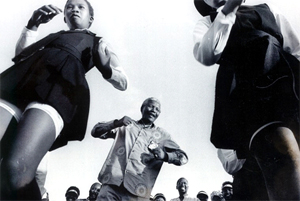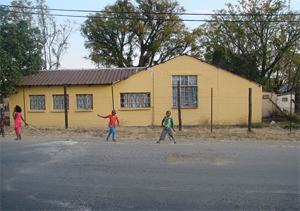Steadville is an African township situated in Ladysmith/Emnambithi, KwaZulu-Natal. The name Steadville comes from the Stead family, particularly Frederick Stead. It is believed that this was due to his involvement in the Bantu Affairs Department as the Principal Clerk to the Native Commissioner. He retired in 1931 after 32 years of service. Although it is not clear exactly when the district between Pieters and Ladysmith was named Steadville, its first inhabitants moved to the area in 1932 and the first township was called Rooi. Before then, people resided in Umbulwane (mostly the Majola, Khanyile and Nthangase clans) and KwaNomlebhelele. Rooi was characterised by two-roomed twin houses (a bedroom and a kitchen).
In the thirties, there were no ablution facilities in the yard and therefore bucket systems were used. After Rooi was established, a section called New Look was erected. The houses in the new area were four-roomed houses with communal showers. Later, Jabavu and then White City were established. There seemed to have been class differences in the area as people who resided in White City were mainly teachers, policemen, nurses, clerks and security guards. There is also evidence that the houses in White City had running water, and were the first to get flushing toilets and showers in their yards.
 Example of communal showers – left unoccupied (Ntando PZ Mbatha)
Example of communal showers – left unoccupied (Ntando PZ Mbatha)
Not all the inhabitants were allowed to own houses, and home owners were not allowed to extend their houses when their families grew. It was only in the late 1980s, with the establishment of a new section called Subsidy that people were allowed to own their homes. After 1994, people were allowed to own houses in Steadville.
The role of chiefs has always been particularly important and Steadville was led by Chief John Ndlovu. In the early 1920s, urban areas set up advisory boards because Africans were not allowed to run municipalities; they were then “fobbed” off with co-operative institutions. Advisory boards were officially set up under the 1923 Urban Areas Act. In Steadville, members of the advisory board included: Chief John Ndlovu, Henry Khumalo and Simon Nkosi.
 View from the hill –Umbulwane can also be seen (Ntando PZ Mbatha)
View from the hill –Umbulwane can also be seen (Ntando PZ Mbatha)
In the early 1930’s children attended schools in Forb Street, Illing Road, and at Presbyterian, Wesleyan and Anglican Churches. The first school was only established in 1937 with its first principal being Mr Mark Dixon. The school started from First Year (now known as Grade 1), until Standard Four (Grade 6). A new primary school was introduced in 1976 – the Nikela Lower Primary School, situated behind Emnambithi Primary. Although the school started running in 1978, with the first recorded learner being Richard Buthelezi, Emnambithi Primary School Hall was still used to conduct classes. Due to the high number of learners and the shortage of classes, teachers had to take on a system called platooning – This is when learners would change classrooms and teachers by subject as well as alternating days they would attend class. Both schools are still operating in 2015.
 Emnambithi Primary School (Ntando PZ Mbatha)
Emnambithi Primary School (Ntando PZ Mbatha)
The first clinic was at house no 29 on Street 5 – now known as Dingane Street. The first nurse who worked there was Esma Xhala who also served Umbulwane and KwaNomlebhelele. There was one qualified nurse for all these areas.
Steadville would later be the birthplace of award-winning group Ladysmith Black Mambazo and one of South Africa’s best boxers – Thulani“Sugarboy” Malinga.
Nelson Mandela spent some of his last days while underground – before he was arrested in Howick – in Steadville. After his release, he visited the Ladysmith area on several occasions.
Another political stalwart who graced Steadville with his presence was the late Govan Mbeki.
 The First Clinic which is now being used as a residence (Ntando PZ Mbatha)
The First Clinic which is now being used as a residence (Ntando PZ Mbatha)
In 1953, Govan Mbeki became a teacher at Emnambithi Primary School. He had applied for the post after his efforts to get organise rural areas failed The lack of support from the African National Congress (ANC) towards this endeavour also drove him to move to Natal, where he was not well known. In Ladysmith, he actively organised political groups. He formed a close alliance with Dr Achmad Sader (a leading member of the Natal Indian Congress and an heir to Gandhi’s legacy of active organisation in this area in the late 19th century). Mbeki mobilised people at a grassroots level leading up to the Freedom Charter in 1955 and played a major role in the formation of powerful resistance organisations in Steadville and surrounding areas. Residents in Steadville and eZakheni emphasised the importance of Mbeki’s presence in Ladysmith in the early 1950s. One veteran of the struggle reported:
 Nelson Mandela with learners from Steadville High School and members of the community
Nelson Mandela with learners from Steadville High School and members of the community
“In 1948-49 I was just a supporter of the ANC; I was not a proper member, just a supporter here in Ladysmith where I used to visit Dr Sader and others. I was not very happy because we were told that meetings were run by educated people. Ordinary people like me were not allowed to join. There was that feeling that the movement belonged to the elite”¦ Things changed when Mbeki was transferred here in the 1950s. He taught at Steadville and also at the Ephumakeni School in Roosboom (a freehold community about 10km outside of Ladysmith). In his part time he would go and organise the workers in the coal mine at Platberg. He was also our teacher. We had meetings with him, although this was not allowed in public. There were also certain groups and we met regularly with him. We also met with Dr Sader. Comrade Albert Luthuli used to pay us visits. J Nyembe also used to pay us visits. Another one of our teachers was Stephen Dlamini. In the 1950s, the ANC changed. The Nat Party introduced various laws intended to divide us, but the people came together.”
Meetings with Govan Mbeki came to be known as “Oom Gov’s Univeristy”. In the book by Colin Bundy, Mbeki stated that “I started a dancing school at the Steadville Primary. There was a young lady who was teaching at the same school. She was pretty, she was attractive, and she was my partner. In the afternoons, we used to go there and attract a number of people – teachers and others who wanted to learn about ballroom dancing. I would slip out”¦ if security popped in, people were happily dancing”¦ In the course of dancing, she gave me coverage.” Mbeki left Ladysmith after he was banned from teaching in April 1955. Ballroom dancing continued in Steadville with other known dance instructors being Eric Mnguni, Amigo Zwane and Ntokozo “Mzo” Sithole.
There was later to be a soccer team called Steadville X20 and a theatre group called Imbumba which performed all over South Africa. Steadville is also home to one of the best schools for people with disabilities – Inkanyezi Training Centre, a Special Needs School.
 First library which later became Inkanyezi Special School (Ntando PZ Mbatha)
First library which later became Inkanyezi Special School (Ntando PZ Mbatha)
Hanely E (2003), Stead Family, from RootsWeb, 3 October, [online], Available at https://www.rootsweb.ancestry.com [Accessed: 5 March 2015] ESPN (1996), |Sugar Boy not sweet for Benn , from ESPN, March 2, [online], Available at https://www.espn.co.uk[Accessed: 5 March 2015] Jackson R (2009), |Sugarboy’s sweet and sour career, from Supersport, 31 August, [online], Available at https://www.supersport.com [Accessed: 5 March 2015]|Bundy C, (2013), Govan Mbeki - Ohio Short Histories of Africa, (Ohio University Press)|Hart G, (2002), Disabling Globalization: Places of Power in Post-Apartheid South Africa, (University of California Press), pp. 84-98.|Oral interviews:
Buthelezi, E. ”“ 01.07.2013
Cele, MTC ”“ 10.06.2013
Myeza, TQ ”“ 10.06.2013
Ndlovu, BI ”“ 01.07.2013
Ndlovu, SS ”“ 10.06.2013
Nyathi, G ”“ 08.01.2015